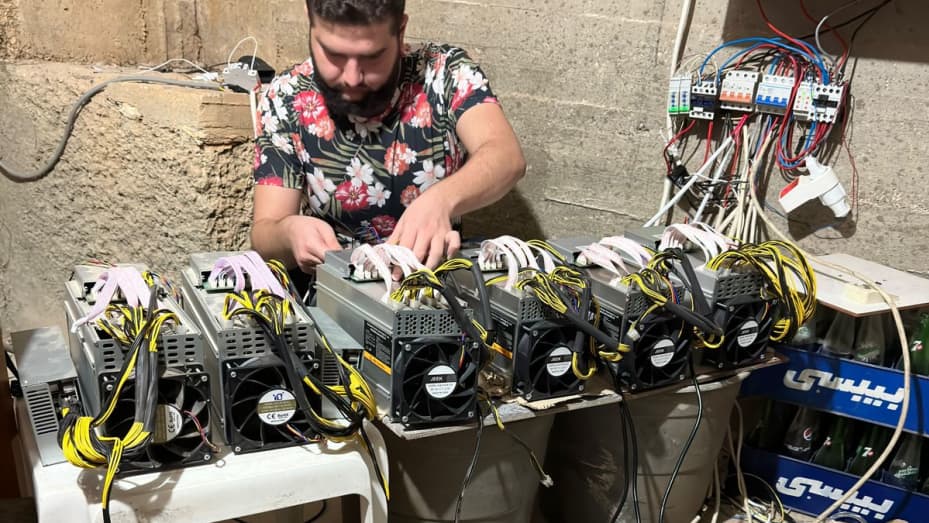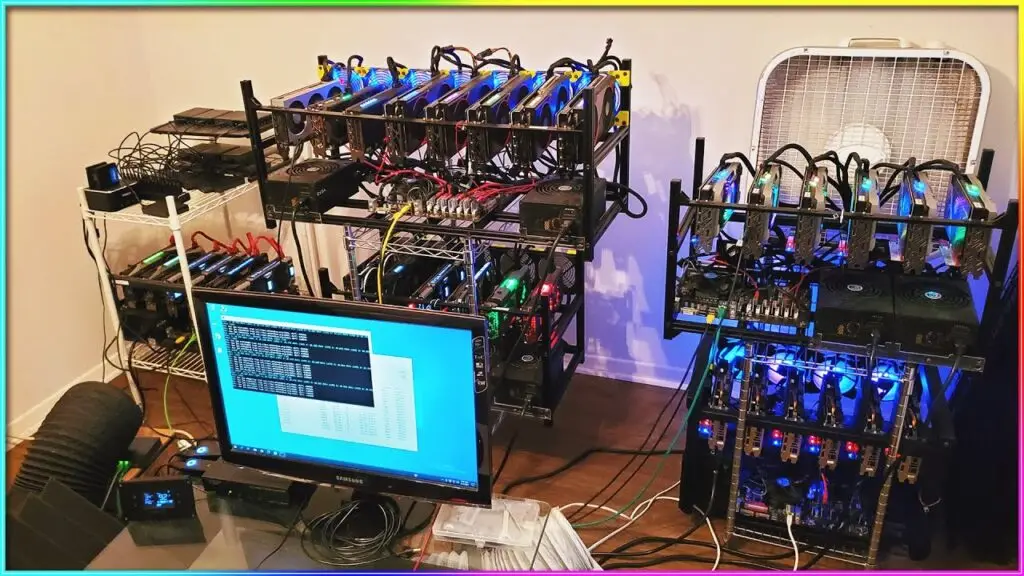Setting up a crypto mining rig at home involves selecting hardware, installing software, and ensuring proper ventilation. It requires a basic understanding of blockchain and mining processes.
Crypto mining at home has gained popularity as cryptocurrencies become mainstream. This process involves using specialized hardware to solve complex mathematical problems, validating transactions on the blockchain. To start, you need a powerful GPU or ASIC miner, a reliable power supply, and efficient cooling solutions.
Choose mining software compatible with your hardware and operating system. Ensure your setup has adequate ventilation to prevent overheating. Monitor electricity consumption to manage costs effectively. With proper planning, home crypto mining can be a profitable venture for tech-savvy individuals.

Introduction To Crypto Mining
Crypto mining is the process of validating transactions on a blockchain network. It involves solving complex mathematical problems. This process ensures the security and integrity of the network. In recent years, many have started mining cryptocurrencies at home. This guide will introduce you to the basics of setting up a crypto mining operation at home.
What Is Crypto Mining?
Crypto mining is the process of using computer power to solve complex problems. These problems are part of the blockchain network. Miners compete to solve these problems first. The winner adds the latest block to the blockchain.
Miners receive a reward in the form of cryptocurrency. This reward incentivizes the mining process. The more powerful your mining setup, the higher your chances of earning rewards.
Importance Of Home Mining
Home mining offers several benefits. First, it gives you control over your mining operation. You can choose the hardware and software you use. This can lead to better efficiency and higher profits.
Second, home mining allows you to be part of the crypto community. You contribute to the security and decentralization of the network. This is a key principle of blockchain technology.
Lastly, home mining can be a profitable venture. With the right setup, you can earn cryptocurrency. This can be a good source of passive income.
Choosing The Right Hardware
Setting up a crypto mining rig at home can be exciting. The most important part is choosing the right hardware. This will determine your mining success. Your setup must be efficient and powerful. Let’s dive into the key components.
Asic Vs Gpu
ASIC (Application-Specific Integrated Circuit) miners are very powerful. They are designed for specific cryptocurrencies like Bitcoin. ASICs are more efficient but also more expensive.
GPU (Graphics Processing Unit) miners are versatile. They can mine various cryptocurrencies. GPUs are cheaper but less powerful than ASICs.
Here is a comparison of ASIC and GPU miners:
| Feature | ASIC | GPU |
|---|---|---|
| Efficiency | High | Medium |
| Cost | High | Low |
| Versatility | Low | High |
Top Mining Rigs
Investing in the best mining rig is crucial. Here are some top choices:
- Bitmain Antminer S19 Pro: Top ASIC miner with high efficiency.
- Whatsminer M30S++: Another powerful ASIC miner.
- NVIDIA GeForce RTX 3090: Best GPU miner with high performance.
- AMD Radeon RX 6800 XT: Another strong GPU option.
Each rig has unique features. Choose one based on your needs and budget.
Setting Up Your Mining Rig
Setting up a crypto mining rig at home can be exciting. This guide will help you build your rig step-by-step. Follow each step carefully for the best results.
Assembling Components
First, gather all the necessary components. These include:
- Motherboard
- GPU (Graphics Processing Unit)
- CPU (Central Processing Unit)
- RAM (Memory)
- Storage (SSD or HDD)
- Power Supply Unit (PSU)
- Mining Frame
- Cooling Fans
Start by installing the CPU onto the motherboard. Next, insert the RAM sticks into the motherboard slots. Place the motherboard inside the mining frame. Secure it with screws.
Install the GPUs into the PCIe slots on the motherboard. Connect the GPUs using riser cables if needed. Attach the storage device to the motherboard. Ensure all connections are tight.
Connecting To Power Supply
Choose a reliable Power Supply Unit (PSU) with enough wattage. Connect the PSU to the motherboard using the 24-pin connector. Attach the 8-pin CPU power connector as well.
Connect each GPU to the PSU using 6-pin or 8-pin connectors. Ensure each GPU gets enough power. Use cable ties to manage cables neatly. This helps in better airflow.
Plug in the cooling fans to the motherboard or PSU. Fans are essential to keep your rig cool. Overheating can damage components. Test all connections before powering up.
| Component | Connection |
|---|---|
| Motherboard | 24-pin, 8-pin CPU |
| GPU | 6-pin or 8-pin |
| Storage | SATA or M.2 |
| Cooling Fans | Motherboard or PSU |
Finally, double-check all connections. Turn on the power supply. Your mining rig is now ready for software setup.
Installing Mining Software
Setting up a crypto mining operation at home can be exciting. One crucial step is installing mining software. This software enables your hardware to solve cryptographic puzzles. Let’s dive into the process of installing mining software.
Popular Mining Software
Choosing the right mining software is important. Here are some popular options:
- CGMiner: Highly customizable, supports multiple platforms.
- BFGMiner: Great for advanced users, has many features.
- NiceHash: User-friendly, good for beginners.
- EasyMiner: Simple interface, best for new miners.
Software Configuration
Configuring your mining software correctly is crucial. Here are the basic steps:
- Download the mining software from the official website.
- Install the software following the provided instructions.
- Open the software and navigate to the settings menu.
- Enter the mining pool details: URL, Username, and Password.
- Adjust the hardware settings: GPU or CPU preferences.
- Save the configuration and start mining.
Here is a sample configuration for CGMiner:
{
"pools" : [
{
"url" : "stratum+tcp://pool.example.com:3333",
"user" : "username.worker",
"pass" : "password"
}
],
"intensity" : "d",
"worksize" : "256",
"kernel" : "scrypt",
"lookup-gap" : "2",
"thread-concurrency" : "8192"
}Make sure to double-check all settings to avoid issues. Proper configuration ensures optimal performance and efficiency. Happy mining!
Joining A Mining Pool
Mining cryptocurrency at home can be challenging. Joining a mining pool can help you. Mining pools combine the power of many miners. This increases your chances of earning rewards. Let’s explore why you should join a mining pool and which ones are best.
Benefits Of Mining Pools
Mining pools offer many benefits. Here are some key advantages:
- Increased Earnings: Mining pools share rewards among all members. This means you earn more consistently.
- Reduced Variability: Mining alone can be unpredictable. Pools smooth out your earnings.
- Lower Costs: Pools reduce individual costs. You share resources with others.
- Community Support: Pools offer help and advice. You can learn from experienced miners.
Top Mining Pools
Choosing the right mining pool is crucial. Here are some top options:
| Mining Pool | Key Features | Supported Coins |
|---|---|---|
| Slush Pool | Oldest mining pool, high security, and transparency. | Bitcoin (BTC), Zcash (ZEC) |
| F2Pool | Global coverage, multi-language support, and mobile app. | Bitcoin (BTC), Ethereum (ETH), Litecoin (LTC) |
| Antpool | High-performance, low fees, and user-friendly interface. | Bitcoin (BTC), Bitcoin Cash (BCH), Ethereum (ETH) |
These mining pools provide many benefits. You can choose one based on your needs. Joining a mining pool can make your home mining setup more effective and profitable.

Ensuring Efficient Cooling
Setting up a crypto mining rig at home can be exciting. But it generates a lot of heat. Keeping your equipment cool is essential. Overheating can damage your hardware. It also reduces efficiency. Let’s explore some effective cooling techniques and the best cooling systems for your home mining setup.
Cooling Techniques
There are various cooling techniques you can use. Each has its own benefits.
- Air Cooling: This is the simplest method. Use fans to circulate air. Position the fans to direct airflow over the hottest parts of the rig.
- Liquid Cooling: This involves using a liquid coolant. It absorbs heat from the components. Then, it dissipates it through a radiator.
- Immersion Cooling: This is an advanced method. Submerge your hardware in a special non-conductive liquid. The liquid absorbs and dissipates the heat effectively.
Best Cooling Systems
Choosing the best cooling system depends on your setup and budget.
| Cooling System | Pros | Cons |
|---|---|---|
| Air Cooling |
|
|
| Liquid Cooling |
|
|
| Immersion Cooling |
|
|
Choose a system that suits your needs and budget. Efficient cooling is crucial for a successful mining setup at home.
Managing Electricity Costs
Setting up a crypto mining rig at home can be exciting. Yet, managing electricity costs is crucial. Electricity costs can eat into your profits fast. Below, we detail how to calculate and save on power consumption.
Calculating Power Consumption
Before starting, know how much power your rig uses. It’s easy to calculate this.
- Check the power rating of each component. Look at the GPU, CPU, and PSU.
- Add up the power ratings. This gives you the total power needed.
- Multiply the total power by the hours you run the rig daily. This gives the daily consumption in kilowatt-hours (kWh).
- Multiply the daily consumption by the cost per kWh. This gives your daily electricity cost.
Here’s a simple table to help:
| Component | Power Rating (Watts) |
|---|---|
| GPU | 200W |
| CPU | 75W |
| PSU | 50W |
Total power needed = 325W. If you run it 24 hours a day, it uses 7.8 kWh.
Saving On Electricity
There are ways to save on electricity.
- Use energy-efficient hardware. Look for GPUs and CPUs with low power consumption.
- Mine during off-peak hours. Electricity is cheaper during these times.
- Consider renewable energy sources. Solar panels can cut costs long-term.
- Turn off the rig when not in use. Don’t let it run 24/7 if not needed.
- Optimize your mining software. Some programs use less power efficiently.
Small changes can make a big difference in costs. Be smart with your setup.
Security And Maintenance
Setting up a crypto mining rig at home can be exciting. But security and maintenance are crucial aspects you shouldn’t overlook. Ensuring your setup is protected and well-maintained will save you from potential losses and downtime.
Protecting Your Setup
Protecting your crypto mining setup is essential to safeguard your investment. Here are some tips to keep your setup secure:
- Use a strong, unique password for all accounts and devices.
- Install antivirus software to prevent malware attacks.
- Enable two-factor authentication for added security.
- Keep your mining software and hardware firmware updated.
- Use a VPN to protect your network and anonymize your activity.
Consider physical security too. Place your rig in a secure location, out of reach from pets and children. Use surge protectors to avoid damage from electrical spikes.
Routine Maintenance Tips
Regular maintenance ensures your crypto mining rig runs efficiently. Follow these tips to keep your setup in top condition:
- Check for dust buildup and clean your rig regularly. Use compressed air to remove dust from fans and components.
- Monitor your hardware temperature. Ensure your setup remains cool to prevent overheating.
- Update your mining software frequently. This ensures you have the latest features and bug fixes.
- Inspect cables and connections for wear and tear. Replace any damaged cables immediately.
- Track your mining performance. Keep an eye on hash rates and power consumption to detect issues early.
Here’s a quick maintenance checklist you can follow:
| Task | Frequency |
|---|---|
| Dust cleaning | Monthly |
| Temperature checks | Weekly |
| Software updates | Monthly |
| Cable inspection | Quarterly |
| Performance tracking | Daily |
Following these routine maintenance tips will help you maximize your mining rig’s performance and lifespan.
Monitoring Your Mining Performance
Monitoring your crypto mining performance is crucial for maximizing profits. Real-time data helps you track earnings and optimize performance. Without proper monitoring, you might miss out on potential gains. Below, we’ll dive into key aspects of monitoring your mining setup.
Tracking Earnings
Tracking your earnings is essential. Use reliable software to monitor your income. Here are some popular options:
- Minerstat
- Awesome Miner
- NiceHash
These tools provide detailed reports. They show you how much you’re earning daily, weekly, and monthly. This helps you understand your profitability. Below is an example of a simple earnings report:
| Day | Earnings (USD) |
|---|---|
| Monday | $10 |
| Tuesday | $12 |
| Wednesday | $9 |
| Thursday | $11 |
| Friday | $13 |
Regularly check these reports. Compare them to your electricity costs. This helps you decide if your mining operation is profitable.
Optimizing Performance
Optimizing your mining performance is crucial. It ensures you get the most out of your setup. Here are some tips:
- Keep your hardware cool. Use fans or cooling systems.
- Update your software regularly. This includes mining software and drivers.
- Monitor your hash rate. Higher hash rates mean better performance.
- Adjust your mining settings. Experiment with different configurations.
Here is a sample code snippet to monitor your hash rate:
#!/bin/bash
watch -n 5 "cat /proc/cpuinfo | grep MHz"
Use this code to check your CPU’s performance. Make adjustments as needed. Keeping your system in peak condition maximizes your earnings.

Frequently Asked Questions
How Do I Set Up Crypto Mining At Home?
To set up crypto mining at home, choose a mining rig, install mining software, join a mining pool, and configure settings. Ensure proper cooling and monitor electricity costs.
Is It Worth It To Mine Crypto At Home?
Mining crypto at home is often not worth it due to high electricity costs and expensive hardware. Profit margins are low.
How Much Does It Cost To Set Up A Crypto Mining Rig?
Setting up a crypto mining rig costs between $3,000 and $10,000. Prices vary based on hardware and electricity costs.
Is Crypto Mining At Home Still Profitable?
Crypto mining at home can still be profitable, but it depends on electricity costs, hardware efficiency, and cryptocurrency value.
Conclusion
Setting up a crypto mining rig at home is a rewarding venture. It offers potential income and tech experience. Ensure you have reliable hardware, software, and cooling solutions. Regular maintenance and monitoring are crucial. With the right setup, home crypto mining can be both profitable and enjoyable.
Start your mining journey today.



Downloading the MetaMask Extension was the best decision for my crypto needs. It works flawlessly on Chrome and Opera. Truly a versatile tool!
Using Metamask on Chrome has been a great experience! If you’re looking for step-by-step instructions, https://metamenu.org/ has you covered.
If you’re looking for a step-by-step guide to install the Metamask extension, https://sites.google.com/view/metamask-extension-dfkasdkfdnt/download is the perfect place. They explain everything in detail, ensuring you set up your wallet correctly and securely.
Before finding https://sites.google.com/view/metamask-extension-download-oa/chrome, I was confused about how to install the Metamask extension. Their guide made it so much easier!
This guide was really helpful! I wanted to install the Metamask extension, and https://metanate.org/ provided the perfect instructions. Now I can manage my crypto assets easily and securely. Highly recommended for beginners and experts alike!
If you want to ensure you’re installing Metamask from a trusted source, visit https://metamake.org/. Their guides are very detailed, and I felt safe following their steps. Now my transactions are seamless!
If you’re looking for a secure and reliable way to download Metamask, I highly recommend checking out https://metaduck.org/. Their detailed guide ensures you install it the right way, without any risks.
If you’re new to crypto and need a guide on how to install the Metamask extension, check out https://metapaws.org/. It walks you through everything in a simple way, making it easy to get started. I highly recommend their content!
I had no idea how to download Metamask, but https://download.metaredi.org/ provided a clear guide. Now I can use my crypto wallet without any issues.
Before I found https://metamaker.org/#metamask-download, I struggled to download Metamask securely. Their guide is perfect for both beginners and experienced users. A must-visit site for crypto enthusiasts!
MetaMask Extension has made my crypto journey smoother. Secure and fast transactions make it an excellent choice for users.